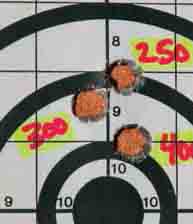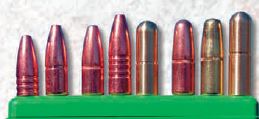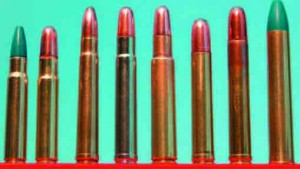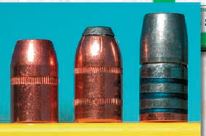
The author set out to design a “sensible” big bore cartridge which would duplicate the performance of the classic .404 Jeffery or the .400 Nitros… but with modest powder charges. Key to shooter success and acceptance would be a special “EXPRESS” load that would duplicate the recoil of the .30-06 but offer a much bigger bullet. This load would be great for hogs, elk black bear, moose, or even African plains game.
Most serious hunters bound for Africa or Alaska in search of large, or heavy, dangerous game, often stop in caliber size at the medium bore .375 H&H. Of course, if things go wrong, not only do even bigger bores work much better- such as the .416s, .458s or even the .500 Nitro, but they also feel a lot more comforting in the hunter’s hands- especially if things take a turn for the worse.
Alas, few shooters can handle the tremendous recoil they dish out. How much more recoil do they produce than the classic .375 H&H? PLENTY! In like weight rifles, the .416 Remington has 45% more recoil than the .375. The .416 Rigby has 56% more. The .458 Winchester Magnum and .458 Lott have 66% and 96% more recoil, respectively. The .500 Nitro with 100 grains of powder under a 570-grain bullet dishes out 134% more recoil than the .375 H&H! Scoping any of these bruisers would surely result in a nasty scope cut on the forehead. With open sights, you are limited to shots not much over 100 yards with any of the above. Accurate shot placement is also much more difficult in the field with open sights.
For these reasons, most professional hunters or guides recommend bringing a scoped medium bore .375 for the task. Fortunately, they will probably carry one of the aforementioned big bores to sort things out should things take a turn for the worse. Personally, I do not care for having to rely on someone else to finish what I have started.
Installing a muzzle brake is NOT the way to go on a big bore rifle. The muzzle blast from a brake in the field feels much worse than an ice pick in the ear. Ethically, as your tracker, PH, or guide make their living out in the field, who are we to cause permanent hearing loss to others just because we find a big bore rifle’s recoil objectionable?
Long ago, I had achieved excellent field results with the .376 Steyr. Repeatedly, I had gotten almost full-length penetration in zebras (5+ feet, from the front or the rear) using the 270-gr Barnes X bullets. Looking at the 350-gr...
.416 bullet from the same maker, I felt if I could achieve similar velocities with the larger and heavier bullet, that would result in a very respectable increase in power. I looked hard at simply opening the .376 Steyr case up to .416 caliber to achieve the performance I was after- and that was the route I chose to go.
Calculations showed that at this speed, the lighter bullet would have recoil similar to a .30-06.
With a more modest capacity in comparison to the .416 Remington or Rigby, I also felt it would be much better for developing a special “Express” load that most any shooter could handle. My goal for it would be a 250-gr bullet at the same speed as a full-power load for the 350-gr bullet. Calculations showed that at this speed, the lighter bullet would have recoil similar to a .30-06. So if a shooter could handle the ‘06, they would be comfortable also shooting the Expressload.
I also wanted to duplicate the velocity of the classic .404 Jeffery and the .400 Nitros- a 400-gr bullet (soft point or solid) at a respectable 2,150 fps. Hopefully, with some luck and careful load development, the three weights might impact fairly close at 100 yards so as to make resighting in the field unnecessary. My final goal was to hopefully not have it generate appreciably more recoil than the .375 H&H. Were all of these goals possible, or was my wish list a few items too long, or perhaps too optimistic?
I am happy to say that all have been easily met, and other important ones were also realized. Most importantly, the .416 Steyr is a pleasure to shoot for even 50 rounds at a time. This is something that no other big bore could ever hope to claim. Finally, hunters have a better alternative to the .375- a sensible big bore rifle- the .416 Steyr.
Chapter 1: The .416 Steyr
Click to LOAD DATA SHEET
With the parent cartridge being the .376 Steyr, I first looked at critical dimensions to see if any changes might be necessary. Close communications with Dave Manson, from Manson Precision Reamers (www.mansonreamers.com), resulted in some helpful suggestions. Dave was able to provide me with a set of chambering and die making (sizer die) reamers in a very prompt manner. Once the barrel...
was chambered, both reamers were sent off to Redding (www.redding-reloading.com) for a set of custom full length dies.
They came to me with a tapered expander ball that smoothly took the parent case up from .375 to .416. I simply lubricated the inside of the case neck using a cotton swab and Imperial Sizing Die Wax- also available from Redding- and ran each case up into the FL die. The resultant formed case then had its inside neck degreased using a cotton swab and carb/choke cleaner. Priming with Federal 210 large rifle primers gave me a ready to load case. The process is very quick and easy. Many of the Hornady cases have been reloaded over eight times- primer pockets remain tight; trimming has not been necessary. The Redding dies rework the brass in a minimal manner. With the FL die backed off of the shellholder one-eight of a turn, cases so sized feed and chamber smoothly.

Desiring to keep things simple, the headspace dimension was kept the same as the parent case. This allowed for a .376 Steyr headspace gauge to be used for the .416 and also required no changes to the magazine for proper feeding. Though the shoulder seemed to provide an adequate surface area for providing headspace. The body-shoulder junction dimension was increased from 0.475 to 0.490”. This would also provide for a slight increase in powder capacity and increase the shoulder surface area slightly.
Note that while firing the first 300 rounds, made by simply necking up unfired .376 cases, the original shoulder proved to be fully adequate for headspacing purposes. Not one cartridge ever failed to fire due to an insufficient shoulder, allowing for the firing pin to move the case forward without detonating the primer. The base diameter just above the extractor groove was decreased slightly- from 0.508 to 0.506”- so fired cases would have a cleaner look when using the Hornady brass.
Necking the .376 case up to .416 results in the case shortening slightly from 2.36 to 2.33”. As the formed case is virtually identical to a fired case, no fireforming is required. Full-power loads were used right from the start with the first firing serving to fill out the shoulder.
...
Chapter 2: The Rifle
I began by sending off a new ProHunter in .376 Steyr to my gunsmith. My instructions were very simple: install a .416 caliber Shilen stainless barrel with a 1-14” twist, and chamber using the Manson finishing reamer. As the barrel channel in the Steyr gray stock was oversized for the original .376 barrel, increase the outside contour on the .416 to “fill up” the channel space. The 24” barrel was to finish up at 0.785” in diameter at the muzzle- an appropriate length and weight for the cartridge and caliber size. I also had him install the original factory open sights onto the new barrel. At my request, Steyr converted the bolt handle to their Tactical round knob style. This is an excellent shape to have on a dangerous game rifle.
When things take a turn for the worse in the bush, having six extra rounds in your rifle… is much better than having them in your pocket!
The standard gray synthetic stock works well on the .376. I have over 1,400 full-power rounds through mine. However with the .416’s increased recoil, I found that the gray stock was flexing in the magazine sidewall area, causing the tang at the action rear to forcefully contact the stock. When I switched to the black, fiberglass-reinforced stock for the .416, all earlier binding problems disappeared. Now with over 1,500 rounds through this rifle, it is certain that the more rigid black stock is the way to go.
So contoured, the finished empty rifle (with no scope) weighs 8.35 lbs., or about 15 ~ 20 % less than other big bore rifles. It balances perfectly and is of a manageable weight for a rifle that may get carried a lot in the field, but seldom shot. Right from the beginning, I installed an excellent LimbSaver recoil pad by Sims Vibration Laboratory (www.limbsaver.com) on this rifle. Of a totally new design and construction, it provides astounding recoil absorption. I regularly fired 100 plus, full-power loads with no shooter discomfort. The LimbSaver pad is available pre-sized to fit a number of factory rifles plus several incremental sizes that can be ground to fit.
The standard detachable magazine holds 3 rounds, plus one in the chamber. With the Steyr High Capacity Kit installed, you can have a total of 8 + 1 rounds in the rifle. This would be an excellent...
choice for the professional hunter or guide. Note that no other big bore rifle in the world even comes close to this cartridge capacity. When things take a turn for the worse in the bush, having six extra rounds in your rifle is much better than having them in your pocket! Just as important, a quick magazine change will then place eight more rounds on tap- a very comforting feeling for sure.

For accuracy testing I mounted a Leupold Vari-X II, 4-12 power scope using their QRW bases. The moderate recoil of the .416 Steyr never resulted in the scope even coming close to hitting me on the forehead. For hunting use, I would choose to mount their popular 1.75-5 Vari-X III safari scope for even greater eye relief.
Chapter 3: Considerations for the .416 Steyr
There were several goals I had in mind when designing the .416 Steyr. I wanted it to be the first truly “sensible” big bore rifle that most any shooter could enjoy using.
- Duplicate the ballistics of the .404 Jeffery or the .400 Nitros, using 400-gr solids or soft points.
- Have a faster 350-gr Barnes X-Bullet load that would shoot flatter than the 400’s, while offeringmore than adequate weight for heavy game.
- Create a load using the Barnes 300-gr X, which would be adequate for medium-sized game,having it shoot close to the point of impact of the 350’s.
- Develop a special “Express” load for the .416 Steyr using a prototype 250-gr Barnes Triple Shock X-Bullet, which would be indistinguishable in recoil from the popular .30- 06, but offer far more impact on game than a .30 caliber bullet.
- Find a moderate, pleasant shooting cast bullet practice load which can still offer good performance in the hunting field.
- See if .429 caliber pistol/rifle bullets could be sized down to work as inexpensive jacketed rounds for light practice.
While this may seem like a very tall order, I am pleased to announce that all of the above were accomplished during my load development and testing. The results in all areas are very good- in some areas they are...
outstanding!
Chapter 4: Reloading and Special Loads

Starting with the most exciting load developed, my goal was to offer the shooter a .30-06 equivalent-recoil Express big bore load capable for use on deer, hogs, black bear, elk, moose, or medium African game. To achieve these recoil levels, bullet weight had to be dropped to 250-grains. In a conventional soft point bullet, adequate penetration could not be achieved at this weight. I therefore turned to the Barnes X-Bullet design. Looking at the new 350-gr TSX (Triple Shock X), I calculated that by machining off the base and lowest cannelure. The weight should come out very close to 250-grs.
A local gunsmith was taken a box of 50, and in short order I had my special 250-gr TSX bullets. As his method for shortening was not too precise, I did not test them for accuracy, but only for velocity. As the chart for the other Barnes bullet weights tested shows, they are very accurate projectiles. So if and when they are offered as a production bullet, I feel confident they will be more than up to the task. Their superior penetration (even at light-for-caliber weights) is what I was after, and testing proved this to be true.
Using a very moderate charge of 50-grs of Accurate 5744, the 250-gr TSXs obtained a velocity of 2,446 fps and produced calculated recoil that duplicates the .30-06. However, in penetration testing, the 250-gr .416 X from this load penetrated 20%deeper than a 180-gr, .308 Nosler Partition bullet fired at the same speed. I can hardly think of a better load for woods hunting of hogs, bear, or elk than this Express load. An industry first, this would be an effective, sensible, big bore load that could be comfortably handled by most any hunter.
It was also easy to find a charge for use with the 250-gr TSX that duplicated the velocity of the 270-gr load in the .375 H&H. Note that with Accurate 2230 powder, the highest velocity with this bullet was achieved- 3,032 fps. At this speed, and with the penetration performance of the X-Bullet, shots on medium sized game out to 300 yards would...
be no problem at all.
Practice loads for the cartridge were next, as most .416 bullets are quite costly and heavier than needed for this task. Using step down dies, .429 diameter Speer Gold Dot pistol bullets, and the 265-gr Hornady pistol/rifle flat point bullets were swaged down to .416. Accurate loads duplicating the .44 Magnum in a rifle and up to the Hornady .444 Marlin Light Magnum were developed, again using 5744. At light to moderate levels, most any shooter or hunter could not tell the difference between these loads and their favorite .308 or .30-06.
Two great loads were developed using swaged down, gas-checked, lead bullets from Cast Performance Bullets (www.grizzlycartridge.com) also using 5744. At 320-grs, I would not hesitate to use either the lighter or heavier load for woods hunting of game up to moose, with speeds of 1,711 or 1,916 fps. As you can see, Accurate 5744 proved to be an excellent powder for moderate, general-purpose loads in the .416 Steyr.

The 300-gr Barnes X-Bullet shot very accurately at 2,416 fps using IMR 3031, or faster still with Accurate 2230 at 2,631 fps. The first load duplicates the speed of my favorite full-power load which uses the still heavier Barnes 350-gr TSX. The second load exceeds the velocity of a factory .375 H&H, also with a 300-gr bullet. There is not much game in the world that could not be cleanly taken with either of these loads. Note that the first load has only 85% of the recoil of factory .375 H&H cartridges.
With the 350-gr weight, we enter into the realm of large, heavy game bullets. The moderately priced Speer 350-gr Mag Tip bullet proved to be quite accurate, with the best loads shooting into 0.86” or less at 100 yards. The fastest load delivered 2,503 fps with this bullet.
I was also able to realize 2,508 fps with this bullet, using Accurate 2230 powder.
Prior field experience with the 270-gr X-Bullet in the .376 Steyr resulted in 5+ feet of almost full-length penetration in zebras, when driven around 2,478 fps. Short of Cape buffalo, I would not at all be hesitant to take a tough shot on most any game using this load. For a...
big increase in power, the .416 Steyr can be loaded with the new 350-gr Barnes Triple Shock X-Bullet. The 350-gr/ .416 TSX offers a 30% increase in weight and a 24% increase in frontal area over the 270-gr/.375 X. My favorite heavy, dangerous game load with this bullet uses Accurate 2460 for 2,426 fps- with 0.71” 3-shot groups at 100 yards.
You could carry this load in the chamber and then fill the magazine with solids of the same weight for bone-breaking penetration. Loading 66.5-grs of Hodgdon H335 over the Barnes solid gave me 2,410 fps, the velocity preferred by experienced professional hunters for solids. I was also able to realize 2,508 fps with this bullet using Accurate 2230 powder.
The full-power .416 Steyr loads can be easily managed by any hunter who can control the .375 H&H.
Traditional African-bound hunters tend to use 400-gr bullets in their .40 calibers when going after heavy, dangerous game. In soft point or solid, this weight is what was loaded in the .404 Jeffery and the .400 Nitros to take tens of thousands of dangerous game during the early 20th century. Using less than 60-grs of powder, I was able to duplicate and/or exceed the ballistics of these mighty African cartridges. With such a moderate charge and the excellent Limb Saver recoil pad, I can fire 50 or more full-power loads from the bench with no ill effects.
Fast, powerful, and accurate, the Hornady 400-grain soft points or solids shot into around ¾” and less at 100 yards. On heavy, dangerous game, most every hunter can appreciate the 33% increase in bullet weight the .416 Steyr has over the .375 H&H with only slightly increased recoil. The confidence a hunter can get from being able to control a big bore rifle like the .416 Steyr cannot be underestimated.
Chapter 5: Recoil Comparisons
How does the kick of the .416 Steyr compare to popular big bore cartridges? For my baseline, I used the 300-gr load in the .375 H&H. The heaviest recoiling .416 Steyr load
that duplicates the classic .400s, only has 11% more recoil than the H&H cartridge. In the field during your hunt, you would never notice this very slight increase.
The 250-gr Express load has virtually the same recoil as a .30-06 but would impact game with a considerably heavier blow. The lighter 300-gr load has 15% less recoil than the H&H. The top heavy game 350 or 400-gr...
loads recoil only 9 ~ 11 % more than the .375 H&H. If facing large or dangerous game, I would take the 24% increase in frontal area and the up to 33% increase in bullet weight offered by the .416 Steyr, in a heartbeat.
I have fired over 150 rounds of the .416 Steyr from the bench in a single setting while developing loads for this article. There is no way I would ever want to fire more than a dozen rounds from the Remington or Rigby .416s. More than a magazine full of the .458 cartridges or bigger, is best described as a not too pleasant task.
Traditional big bore rifles understandably do not sell very well. Their recoil leaves most shooter wanting to look elsewhere for fun. The full-power .416 Steyr loads can be easily managed by any hunter who can control the .375 H&H. The special 250 grain Express load can truly be handled by most any shooter.
Summary
While I had hoped that some of the various bullet weights might shoot near the same point of impact at 100 yards,
While I had hoped that some of the various bullet weights might shoot near the same point of impact at 100 yards, I was delighted when the following loads were all tried on the same target. The full power 400 and 350 grain loads struck within 3/4 inch or less of each other. Firing one more shot each with the 300 X loaded to the same speed of the 350, and the special 250-gr Express load (also at the same speed) resulted in a composite group that could almost be covered by a a silver dollar! So in the field, a hunter could switch from hunting buffalo- to light or medium game, and back again- by simply changing loads. With the .416 Steyr, there is no need to resight in for each different load.
In his book, African Rifles and Cartridges, John Taylor says of the .400s-
““They are one of the grandest weapons imaginable for all big game hunting… I have used it (the .404) extensively on all kinds of African game from elephant down, with the greatest possible satisfaction… I have never heard any African hunter complain about the .400; on the contrary, they are all very enthusiastic who have used it… practical
experience has shown that it’s a simply splendid weapon for all heavy and dangerous game anywhere… ”
I am extremely pleased with the range performance of the .416 Steyr. It truly is the first sensible big bore rifle cartridge...
ever developed. Out to 200 yards or so, the Express load could drop most any game a hunter might seek while recoiling the same as a .30-06. The heavy loads with 350 or 400-gr bullets easily duplicate the classic .404 Jeffery or the .400 Nitros. A professional hunter in Africa, or an Alaskan guide, would both be well served by the high-capacity magazine kit and the total of nine rounds the shooter has in his rifle to handle sticky situations.